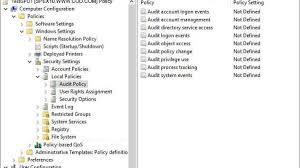The Importance of Using Audit Active Directory Tools
Active Directory is a critical component of many organisations’ IT infrastructure, serving as a centralised database that stores and manages information about network resources. As the backbone of user authentication and access control in Windows environments, it is essential to ensure the security and integrity of Active Directory.
One way to enhance the security of Active Directory is through the use of audit tools specifically designed for monitoring and managing its activities. These tools provide administrators with valuable insights into user actions, system changes, and potential security threats within the directory.
Benefits of Audit Active Directory Tools:
- Enhanced Security: By monitoring user activity and system changes, audit tools help identify suspicious behaviour that may indicate a security breach. They allow administrators to detect unauthorised access attempts and take proactive measures to mitigate risks.
- Compliance: Many industries have regulatory requirements regarding data security and privacy. Audit tools help organisations demonstrate compliance with standards such as GDPR, HIPAA, or PCI DSS by providing detailed logs and reports on Active Directory activities.
- Insightful Reporting: Audit tools generate comprehensive reports that offer insights into user permissions, group memberships, password policies, and more. Administrators can use these reports to assess the overall health of Active Directory and make informed decisions about security configurations.
- Auditing Changes: Tracking changes made to Active Directory objects is crucial for maintaining data integrity. Audit tools record modifications to user accounts, group policies, schema changes, and other critical components, enabling administrators to revert unwanted changes or investigate suspicious activities.
- Real-time Monitoring: Some audit tools provide real-time alerts for specific events or policy violations within Active Directory. This proactive approach allows administrators to respond promptly to security incidents and prevent potential threats from escalating.
In conclusion, utilising audit Active Directory tools is essential for maintaining a secure and compliant IT environment. By leveraging the capabilities of these tools, organisations can strengthen their defences against cyber threats, streamline compliance efforts, and ensure the smooth operation of their Active Directory infrastructure.
Top 5 Tips for Effectively Auditing Active Directory Tools
- Regularly review and monitor user access rights in Active Directory to ensure compliance with security policies.
- Utilize audit trail features of Active Directory tools to track changes made to user accounts, groups, and permissions.
- Set up alerts for suspicious activities or unauthorized access attempts within Active Directory.
- Perform periodic audits of privileged accounts and administrative roles to detect any anomalies or potential security risks.
- Document audit findings and remediation actions taken to maintain a record of security measures implemented in Active Directory.
Regularly review and monitor user access rights in Active Directory to ensure compliance with security policies.
Regularly reviewing and monitoring user access rights in Active Directory is a crucial step in maintaining a secure IT environment and ensuring compliance with security policies. By regularly assessing and updating user permissions, organisations can prevent unauthorised access to sensitive data, reduce the risk of insider threats, and uphold regulatory requirements. Monitoring user access rights also helps identify any discrepancies or anomalies that may indicate potential security breaches, allowing administrators to take prompt action to mitigate risks and safeguard the integrity of their Active Directory infrastructure.
Utilize audit trail features of Active Directory tools to track changes made to user accounts, groups, and permissions.
By utilising the audit trail features of Active Directory tools, administrators can effectively track and monitor changes made to user accounts, groups, and permissions within the network. This capability enables a detailed record of all modifications, allowing for greater visibility into who made the changes, when they occurred, and what specific actions were taken. By maintaining a comprehensive audit trail, organisations can enhance security measures, detect unauthorised alterations promptly, and ensure the integrity of their Active Directory environment.
Set up alerts for suspicious activities or unauthorized access attempts within Active Directory.
Setting up alerts for suspicious activities or unauthorised access attempts within Active Directory is a crucial step in enhancing the security of your IT infrastructure. By configuring proactive alerts through audit tools, administrators can receive immediate notifications of any unusual behaviour or potential security threats within the directory. This allows for swift responses to mitigate risks, investigate incidents, and prevent unauthorised access before it escalates. Implementing alert mechanisms not only strengthens the overall security posture of Active Directory but also empowers organisations to stay ahead of potential cyber threats and maintain a vigilant approach to protecting their critical assets.
Perform periodic audits of privileged accounts and administrative roles to detect any anomalies or potential security risks.
Performing periodic audits of privileged accounts and administrative roles is a crucial practice in maintaining the security of Active Directory. By regularly reviewing and scrutinising these accounts, organisations can identify any irregularities or potential security risks that may compromise the integrity of their IT infrastructure. Detecting anomalies in user permissions and access levels can help prevent unauthorised actions and data breaches, ensuring that only authorised personnel have the necessary privileges within the Active Directory environment. This proactive approach to auditing not only enhances security but also strengthens overall compliance with regulatory requirements and best practices in cybersecurity.
Document audit findings and remediation actions taken to maintain a record of security measures implemented in Active Directory.
It is crucial to document audit findings and the remediation actions taken when utilising audit Active Directory tools. By maintaining a record of security measures implemented in Active Directory, organisations can track and demonstrate their commitment to enhancing system security. Documenting audit findings not only helps in identifying vulnerabilities and potential threats but also ensures that appropriate steps are taken to address them effectively. This proactive approach enables administrators to have a clear overview of the security posture of their Active Directory environment and facilitates continuous improvement in safeguarding critical IT assets.

